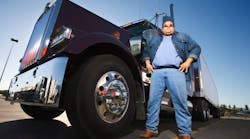I rise today to defend alleged wasteful government spending—at least in one instance. An investment in truck driver health will pay big dividends for the drivers themselves, for highway safety, and for the economy.
At issue is a new report by Sen. James Lankford (R-OK) called “Federal Fumbles: 100 ways the government dropped the ball.” The “playbook” highlights examples of wasteful spending and burdensome regulations “but also offers policy solutions to each of the problems,” according to the senator.
Topping the list is $43 million CNG fueling station the Dept. of Defense built in Afghanistan, because apparently no one thought to consider that there’s no natural gas distribution capability in the country and that the cost of converting a vehicle to CNG exceeded the average annual income of the citizenry.The top 10 items also include the usual gripes about federal spending on arts projects, alternative energy subsidies, and federal employee benefits, along with complaints about school lunch menu requirements and the lack of immigration enforcement.
And tucked in at #8, right after a critique of Dept. of Energy dishwasher efficiency standards, is “Federal Diets,” in which Lankford goes after the $2,658,929 the National Institutes of Health spent to conduct a cellphone-based program for a truck driver “weight loss competition” and “motivational interviewing.”
“Encouraging people to make healthier living decisions is definitely a good thing that should be done—by doctors, families, and friends, not the federal government and not at a price tag for American taxpayers of $2.6 million over four years,” the report says.
And, of course, out of Lanfkord’s list of 100 examples, fat truckers are funny like lost llamas and are audience grabbers for a 60-second news spot. Below is the “Your Money” segment from Monday evening’s World News Tonight on ABC, in which Rep. Joe Pitts (R-PA) weighs in, so to speak.
“It’s just mind boggling,” Pitts says of the trucker study. “I’m sure they’ll come back with some kind of excuse.”
Well, there’s no need for a fresh excuse. NIH spelled out the need for the Safety & Health Involvement for Truckers (SHIFT) study from the get-go:
Poor health amongst commercial truck drivers is a dangerous and costly public health problem. The high rate of obesity in truckers increases their risk for heart disease, stroke, type 2 diabetes and some types of cancer. Driver health problems, especially obesity and related conditions like sleep apnea, are related to driving errors and increased crash rates, impacting both driver safety and the safety of the general public.
Basically, the program coached-up truck drivers on nutrition and proper eating habits, and stayed after them with phone calls to monitor progress. And the program seemed to have scored a touchdown: Total weight loss among follow-up participants averaged 18.4 pounds over a 36-month period (6.8% of original body weight).
“Moderate, sustained weight loss such as this among obese individuals provides clinically significant effects such as normalized blood pressure and reduced cardiovascular risk factors,” the study concluded. “These findings should be viewed as good news for the trucking industry, which generally lacks evidence-based methods for helping truck drivers lose and manage body weight.”
Good news, indeed, for trucking companies having a hard time finding and keeping good drivers. Now, thanks to the help of a federally funded study, carriers have a model plan to work with. That’s good news for the economy, too.
And if a healthier driver is indeed a safer driver, the industry-wide impact of driver wellness programs will certainly save lives—and that benefit, even in the cold calculus that puts the value of a life at $8 million or so, means the NIH grant will pay for itself many times over.
So, sorry, Sen. Lankford. You dropped the ball on this one.





